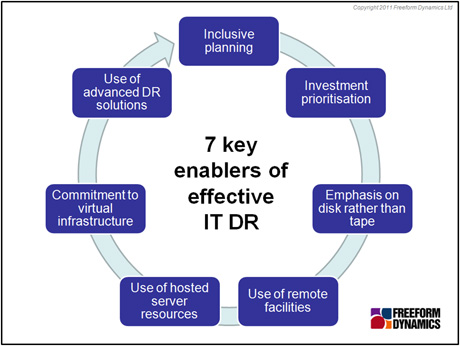There’s no magic bullet, but there’s a formula
Many IT and business executives groan when the topic of disaster recovery (DR) appears on the agenda. While most regard DR as important, it nevertheless often ends up in the same category as taking out insurance cover: you know you need it, really, but you’re trying to keep expenditure to a minimum. And of course the real value of any insurance product only becomes apparent when disaster strikes, which is why DR initiatives often lose out to other projects, both in terms of funding and management attention.
But disaster does strike, and the minimalist’ approach is getting increasingly risky, as businesses are more reliant than ever on the immediate and continued availability of their systems and data. Or put differently: the time span a business can function effectively without access to its most critical applications and data is getting shorter and shorter. This in turn means that the ability to recover quickly from a major incident is more pressing than ever.
So what can companies do to ensure that they’re adequately prepared for when disaster strikes? More importantly, what can they do to make sure that the topic of DR isn’t relegated to ‘Other’ on the management agenda?
A few answers can be found in the results of a survey Freeform Dynamics carried out with small and mid-sized businesses (SMBs). We asked about levels of preparedness, as well as the DR technologies that were used. As was to be expected, we found that some companies were better prepared than others. But we also found a number of factors that the ones who are better prepared have in common. And while the respondent base for this study was SMBs, the lessons that can be learnt are equally applicable to all sizes of organisation.
Seven enablers of effective IT DR
There is no single most important differentiator between those who have better DR capabilities and those who are struggling. But we were able to identify a number of factors that all have a role to play when it comes to putting in place effective measures (Figure 1). This is not to say that these are the only factors – that’s why we’re not referring to them as ‘the seven enablers’.

Figure 1
If you’d like to find out more about each of the individual factors, and also take a look at the actual survey results, a copy of the complete report is available for free download here.
There’s one final consideration to highlight which will make it easier to put appropriate DR mechanisms in place: ‘baking’ DR into all planning and review processes, right from the beginning. If DR is only addressed at the last possible moment before a project goes live, or is considered in isolation, it’s likely to hit roadblocks in terms of management attention and consequently funding. If, on the other hand, DR requirements are taken into consideration right at the beginning – whether it’s in the design of a new process or IT system, or software and/or hardware selection – it is more likely that a solution actually gets defined and implemented.
More than that, there is a virtuous circle here as well: many of the technologies that support more effective DR are the very same technologies that companies are considering anyway as part of modernising their IT infrastructure. If DR is a key consideration in the early planning stages, it is likely that the resulting solution is more cost-effective than anything that’s retrofitted as part of a separate DR project that gets started – almost as an afterthought – in the later stages of planning.
CLICK HERE TO VIEW ORIGINAL PUBLISHED ON
